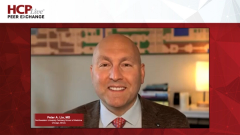
Considerations and Comorbidities Affecting Atopic Dermatitis Diagnosis
Brittany G. Craiglow, MD, and Peter A. Lio, MD, provide insight into the challenges inherent to an atopic dermatitis diagnosis, focusing on the role of diet and a patient’s clinical presentation.
Episodes in this series

Raj Chovatiya, MD, PhD: The billion-dollar question that we all have in our minds is what can we do now to make things better? Not only for us but also for the patients in the long run. You highlighted an interesting point because I see patients who straddle the line when they transition from childhood to adolescents and adulthood. What does that look like in terms of the difficulty for care? In many ways, in the adult world, practitioners are even less educated about the disease itself because of this idea that it’s a childhood disease, so you’re going to outgrow it, and we don’t need to know that much about it. I definitely find that patients have felt like there’s been a step down in terms of some of the care they’ve gotten. This highlights the educational gap. We need everyone on the same page by saying that this is not a specific disease of 1 age group or another. Rather, we rate everyone’s level when it comes to education about the disease process itself.
Britt, you highlighted some interesting things about the other aspects of the heterogeneity and burden. I want to pick your brain about some of the inherent challenges for atopic dermatitis diagnosis in pediatric patients. In particular, what are some of the other potential comorbidities or confounders or things that you find out along the way that sometimes make this picture a little less clear? Because we know that in adults, instead of atopic dermatitis you could have psoriasis, cutaneous lymphoma, and contact dermatitis, which can look the same, but there’s a whole other number of atopic things that could be going on in kids.
Brittany G. Craiglow, MD: Usually, if it looks like atopic dermatitis in a kid, it probably is. We can’t underestimate the potential contribution of contact allergens, especially if a kid is having pretty decent disease control. All of a sudden it seems to be getting worse, and maybe they have heavy facial or hand involvement. I see…sensitivity fairly often in these patients. Something to think about: is there anything new or different that may be contributing to this? In kids, we’ll see this psoriasiform dermatitis that in some places looks like psoriasis, and in some patients it looks a little more like eczema, and some overlap things. Sometimes you can unmask the more prominent 1 with your treatment. Contact allergy is important, especially if you’re thinking about starting a systemic medicine, especially in an older population. That’s 1 thing that we should all have in the forefront, to make sure we’re not missing something. Maybe it’s not the whole picture, but it’s contributing.
Raj Chovatiya, MD, PhD: Peter knows what I’m going to ask him. I want to pick your brain about food allergies and food in atopic dermatitis. We don’t have 3 hours today, so please share your most picky thoughts in a very short period of time—I know you have a lot of good ones.
Peter A. Lio, MD: Thank you. It’s 1 of my favorite things to think about because my patients bring it to me essentially every day over and over. That’s the No. 1 thing on people’s minds. Frankly, both adults and kids with atopic dermatitis are thinking about food. How do I approach it? The big thing is that I try not to be dismissive because we have enough humility to know that everyone is different. We’ve already alluded to the heterogeneity of this disease. There are almost assuredly people out there where food makes a huge difference. What I say to them is “Cheers, that’s great. Congratulations, you don’t need me.” If cutting out strawberries or gluten is all you needed to get better, then God loves you. Go and do great things in the world. Don’t worry, you’re all set. But it stinks when they poison the well and plant this seed that this whole thing is a big conspiracy, so find the right food. We’ve all seen families grind themselves down into dirt trying to find this answer. I’ve seen babies who are malnourished, sick, and not thriving because they just kept restricting their food. We know from the school of hard knocks that this is not the way for everybody. For the vast majority of patients, foods are not a primary driver of this disease. That being said, it’s sometimes easier to focus on diet, to check that box.
My standard advice is that if you have known food allergies, IgE-mediated type hypersensitivity reactions—hives, angioedema, anaphylaxis—you’re going to avoid those foods. That’s critical. We know you’re not cheating because if you anaphylax to peanuts, you’re not secretly taking peanuts and that’s what’s making your skin bad. You’d be dead, so that’s different. If there are foods that you suspect are playing a role, you can hold those off for a while as we treat, but we can’t be too restrictive and take too many things out.
Some of the work of Anne Marie Singh at the University of Wisconsin has changed my thinking, so I can say, “Here’s the danger.” When you cut foods out of your diet, that’s the main way our body gets tolerant to them. If we cut them out, we may become intolerant, and you may make your worst fear become a reality. By cutting out these foods, you may become allergic from an IgE standpoint when you reintroduce them. When we talk to families this way and tell them the table stakes, many will settle down a little, and we can focus on some of these other aspects.
If I have a patient who’s being elusive and I can’t get them better, and they are very refractory, then it can be worth looking at every stone, overturning everything and saying, could there be a food aspect? For my particular clinic, probably for all of ours, almost every patient we see has an allergist as well. We’re not trying to be the lone ranger and be crazy and do something different. We’re working in the context of a team, and many of these patients have been tested—sometimes multiple times—and are doing a very good job of avoiding. For a person, the first time they’re experiencing something, it’s reasonable to consider food. But for our patients, the food tends to be a smaller piece.
The last thing I’ll say is that I truly believe that a healthy diet and a holistic approach are still good. By all means, eat healthy, eat plants, eat good whole foods. That’s going to help us in a number of ways. I don’t want to deter people from that, but I feel bad when people are cutting out practically everything from their diet in this effort. It’s honorable, but it’s a quixotic effort to find that solution.
Raj Chovatiya, MD, PhD: Quixotic—that sums up the entire ordeal, doesn’t it? With the elimination diets we’ve all faced, I feel awful, particularly when you’re talking about kids. That’s the time you’re eating a bunch of new, exciting stuff, so it’s a tough place to be. All this highlights the patient burden of the disease when we think about it. Forget about the actual disease. Some of the lengths people will go to achieve better control of their disease oftentimes adds even more on the burden. That’s not even thinking about the health care providers themselves and what I like to call the iatrogenic burden of the things that we sometimes do, in terms of making life miserable or complicated. That’s a hallmark of this disease and makes it so different from some of the other dermatologic conditions.
Transcript Edited for Clarity
Newsletter
Access practical, evidence-based guidance to support better care for our youngest patients. Join our email list for the latest clinical updates.



